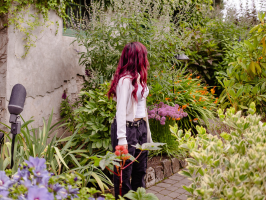Discover types of worlds for your story


Worldbuilding can be broken down into four main types, depending on how complex the world is.
Normal World
“Normal world” worldbuilding is the kind of worldbuilding we see in contemporary romance, contemporary Young Adult, New Adult, and college stories. These stories are set in the everyday, regular world that does not require specialized knowledge to understand. In this kind of worldbuilding, we want to get a sense of the distinct details that give this place its character, because we basically already know how the world works.
If your story is set in a famous city like New York or Paris, we want a sense of the things we know about those cities. If your story is set in a high school, we want to have a particular sense of this individual high school, its social makeup, its weird traditions, etc.
Examples: high school, coffee shop, small town, college, etc.
Worldbuilding questions:
- What are some features of your setting that are particular to this place and make it different from similar kinds of places?
- What are common features of your setting that everyone there recognizes?
- Who are the background characters in your setting?
- What particular traditions, rituals, catchphrases, and shared understandings do people in your setting have?
- What’s important to the people here?
Example stories:
Niche Normal
Niche Normal describes a type of worldbuilding that is still set in our regular world, but has an added layer of specificity that informs the plot of the story. Examples of this are sports romances and workplace romances. Everything is the same as the regular world, but there’s a little bit of extra context you need to convey to the reader so that they can understand what is going on. For example, with a sports romance, the structure of the league, what it means to win or lose any given game, and how the game itself is played all matter to how the romance plays out because it sets the stage for the romance story and informs the events of the story.
Examples: sports teams, office/workplace, firefighters/medical, courtroom, niche hobbies
Worldbuilding questions:
- What particular experiences do your characters have because of their setting that they wouldn’t have outside of it? How does this shape the story?
- How does the setting shape the story’s conflict?
Example Stories:
Trope World
Trope World describes a kind of worldbuilding where the story’s setting deviates from everyday life, but it deviates in particular established ways that are grounded in subgenre. Examples of this are regency romance, mafia, and werewolf. All of these subgenres take place in worlds a bit different from our regular world, where the rules of the society are slightly different from what the reader knows from everyday life, but in each subgenre, there is a lot of shared understanding in how the worlds are “supposed” to work. The settings vary from our everyday world, but there is not a huge amount of variation in the worlds of different books. This is not a bad thing! Readers are passionate about Trope Worlds because the worlds are similar from story to story. Readers love the combined sense of familiarity and excitement that comes from a world that is different from our own, but that still plays by a knowable set of rules.
Examples: mafia, werewolf, regency romance, horror
Worldbuilding questions:
- What do you think readers like about this kind of world? What elements do they need to see to recognize the world they’re reading about?
- How does your world deliver on those reader expectations?
- What details make your world different from the regular world? How do those details shape your characters’ emotions?
- How does the setting shape the story’s conflict?
Example stories:
Alternate World
Alternate world is a type of worldbuilding where the story world is completely different from our regular world, and there’s not a lot of overlap in how the world works across different books. This can either be a fully invented different world like Middle Earth or the Star Wars “galaxy far away,” (sometimes called a Secondary World) or it can be attached to our contemporary world but with a lot of distinctive magic or tech elements, like Harry Potter or the Anita Blake series. Alternate World worldbuilding is distinguished by its complexity; the reader has to take on a lot of new information in order to understand how the story works, and there’s not a lot of overlap with other books in the same subgenre. Part of the pleasure of this kind of story is seeing how the world is different from other worlds in the same genre, whereas with a Trope World, the pleasure comes from seeing how the world is the same. Neither is better or worse, it just depends on what story you want to tell. As with all worldbuilding, the goal is to make the world feel emotionally real to the reader. With Alternate Worlds, there is an additional challenge of conveying complex information to the reader in an organic way, so that they understand what is going on but aren’t overwhelmed or bored by long passages of explanation.
Worldbuilding questions:
- What features of this world are unique? How does the magic/tech work?
- How much do the characters understand about how the world works?
- How much does the reader need to know about how the world works?
- What shared culture exists in this world? What conflicts about culture exist in this world?
- What is the history of the significant places in this world?
- How does the setting shape the events of the plot?
Example stories:
Going deeper on Trope Worlds
A Trope World is a world that is based in the conventions of the story’s subgenre. The story’s world differs from our regular world in significant ways, but the rules of those differences are pretty similar from story to story. The society depicted is different from our society, but all the settings share a recognizable set of characteristics determined by the subgenre of the story. Examples of subgenres that rely on Trope Worlds are regency romance, werewolf, and mafia.
The new and the familiar
All stories balance the new and the familiar, but in the Trope World setting, the emphasis should be on what is familiar and shared among the subgenre.
Trope Worlds promise a certain reading experience based on commonly-understood features of the world. If a regency romance doesn’t have the ton and strict rules about marriage and sex, it’s not fulfilling the basic Trope World conventions of the genre. Similarly, if a werewolf story doesn’t have a pack structure and the concept of “mates,” it’s not fulfilling reader expectations for the Trope World. In both cases, the dedicated readers of these subgenres are likely to be disappointed in the story because they came to the story with certain expectations of the world based on the subgenre.
It can be fun to play with reader expectations, but the purpose of the Trope World is to fulfill those reader expectations. Readers who like Trope Worlds like the sense of continuity across stories, and when you’re writing in a Trope World subgenre, you should be aware of those reader expectations and fulfill them at least in part. If you’re not prepared to fulfill at least some Trope World expectations, you might want to reconsider the genre you’re writing. For example, if you want to write a romance novel set in 1815 with working class main characters whose main external conflict is around enclosure and rising industrialization, you may have written a romance novel set in the Regency period, but it’s not really a “regency romance” by conventional definitions of the subgenre, since it’s not partaking of the Trope World. You can still write it, but be prepared to reach a much more niche audience.
Recognizing the foundational elements of the Trope World you’re working with is essential to writing well in that subgenre. Read other stories in your target genre and see what similarities recur across the genre. Those are the things you’re likely to want to keep. What are the commonalities among those elements? What do you think the reader gets out of them?
We’re not saying every Trope World story has to be the exact same as every other in its subgenre, or that you can’t have exciting new elements in your worldbuilding. Introducing new elements to a Trope World can be a fun way to differentiate your story, but make sure the core of the Trope World remains present and recognizable. Try to limit these new elements to things that are absolutely essential to your story. Remember that Trope World readers are overwhelmingly interested in a familiar setting, so make sure that your setting delivers on that expectation. Don’t let the new elements upstage the familiar ones, and make sure those new elements are important to the story.
Common Trope World Elements
Let’s have a look at some common Trope World elements, as well as the effect they have on the stories. We’ll focus on Werewolf and Mafia, since these are priority genres for Wattpad.
Werewolf
|
Trope World Elements |
Effect on the story |
|
Hierarchical werewolf pack Werewolf packs have strict social roles of alpha, beta, omega, etc. These are sometimes/often biologically determined. Hierarchy is strict and socially enforced by all members of the pack. The main character is almost always of a lower social position than the alpha romantic interest, and is often an outcast in the pack. |
A source of conflict for the leads in the power difference between their social roles. Simultaneously also offers a sense of belonging and togetherness once the main characters are together. |
|
Alpha pack leader The werewolf pack is led by the “alpha,” who is often biologically different from other werewolves, inherits the title by birthright, or is otherwise destined to the role in some way. The alpha is the biggest, strongest werewolf and is the final decision maker in the pack and in charge of the safety and wellbeing of all pack members. |
The romantic lead is the most powerful person in the story; serves as a power fantasy of a protective, possessive lover who desperately desires the main character and takes care of every need. |
|
Luna The alpha’s mate, usually a position of honor in the werewolf pack. |
A specific role for the main character to occupy; confirmation that MC is special in their community. Contrast with the low position the MC starts out in. |
|
Mates Werewolves are magically or biologically driven to find their true or fated mates. Everyone has one destined perfect partner, and being without this person causes physical or psychic pain. The leads are fated mates, and are destined to be together because of this. |
Source of romantic draw between the leads, as well as a source of romantic conflict as they reject or try to negotiate the bond. Offers a romantic fantasy to the reader of one perfect partner. |
|
Shifting Characters can turn into wolves, usually at the full moon but sometimes at will. This grants them access to heightened senses and sometimes telepathy. |
Wolf form allows characters to express and sense emotions they can’t in human form; serves to advance the plot and romantic arc. |
As we can see, these common Trope World elements play a specific role in shaping the kinds of stories that fall into the Werewolf subgenre. Negotiating hierarchical pack structures and having a destined mate are part of the draw of werewolf stories; they are a fundamental part of the genre setting and its appeal to readers. They create the shape of the conflict that the reader expects to see when they open a werewolf story. The central draw of the werewolf genre is the mate bond, the overwhelming desire to be with one’s destined partner. All the Trope World worldbuilding supports this central draw by adding in complexity and conflict to this basic concept.
If you are adding in new elements, how might they interact with these established genre elements? How do they either amplify the central premise, or provide more conflict to it?
You can certainly write a werewolf story without some of these elements, but deviating too far from this probably puts your story into paranormal romance or urban fantasy, rather than the werewolf subgenre specifically.
Mafia
|
Trope World Elements |
Effect on the story |
|
Mafia crime families The crime world is organized into mafia families, headed by powerful men, who are bound by blood relation, marriage, and strict codes of loyalty, duty, and tradition. |
Creates an insular group with its own codes of behavior that the characters must navigate through, which drives narrative conflict. These codes often either create the conditions for the plot (e.g. arranged marriage) and/or deepen the conflict as the characters must choose between desire and duty. |
|
Mafia Don The romantic lead is high-placed in the mafia family, usually at its head, and commands a position of respect and fear from those around him. |
The romantic lead is the most powerful person in the story; serves as a power fantasy of a violently protective, possessive lover who takes care of every need. The mafia don is violent with everyone except the main character, emphasizing the uniqueness of their relationship. |
|
Mafia conflict/war There is conflict, usually violent, between multiple mafia families, or the mafia and other organized crime. |
Drives external conflict in the story and creates a sense of danger and high stakes that informs how the romance develops. Often provides the context for plot events like kidnappings, assassination attempts, etc. |
|
Secret/underground society The mafia is an underground organization, and preserving secrecy is important to how the mafia conducts itself. |
The sense of secrecy and being held apart from the normal world raises the stakes and creates the conditions for the mafia codes that shape the characters’ actions. |
|
Wealth Mafia families are wealthy and live a luxurious lifestyle, often in metropolitan areas or in Europe. |
Creates a lush, beautiful setting that usually results in the main character getting a makeover, expensive clothes and vacations, etc. Creates a fantasy for the reader of wealth and beauty. |
In Mafia, the Trope World works together to give us a picture of an underground society governed by its own rules, where luxury is everywhere and violence is commonplace. This is what makes mafia a Trope World, rather than a niche normal world—the rules of society in mafia romance are extremely different from everyday society, and these rules serve to set up the central draw and central conflict of the story. Readers come to mafia for the depiction of a relationship with a powerful lover (almost always a man) who is violent with everyone but his beloved, fiercely protective, and is bound by a code of honor and tradition. The high stakes world of the mafia allows for exciting events that add drama and spice to the romance.
When you’re worldbuilding your mafia romance, consider the central draw of the genre. How can new elements add to the central premise?
Making Trope Worlds unique
Though they share a lot of similarities from story to story, Trope Worlds are not cookie cutter! Being inhabited by unique characters with their own emotional journeys within the context of a familiar world is what makes the Trope World compelling to readers. Readers like the similarity of Trope Worlds, but that doesn’t mean your Trope World has to be boring.
A few well-placed details will make your story world feel unique, while preserving the central draw of the Trope World. Grounding those details in character backstory will make the characters feel like an organic, embedded part of the world.
For more on this, check out our worksheet. You can also use the memories exercise in our character worksheet to flesh out the relationship between the characters and the setting. Use those details to guide your descriptions of the world you’re building.
When you’re worldbuilding for a Trope World story, it can be fun to add in some new elements that make your story unique. When you’re doing this, it’s important to preserve the central premise of the subgenre. When you’re adding in new elements to the Trope World, think about how they interact with the central premise of the subgenre. What kinds of things are now possible in your story that the basic elements of the Trope World don’t provide? How do you plan on using those elements? How do your new worldbuilding elements serve to raise the stakes? When you’re adding new elements to a Trope World, it should be for a concrete reason that adds something specific to the story you can’t get any other way.
Going deeper on Alternate Worlds
An Alternate World is a type of story setting where the world of the story is drastically different from our everyday world, and there’s not a lot of overlap between stories even in the same subgenre. In each story, the author is introducing the reader to the world from the ground up. In Trope Worlds, there are specific conventions the reader is expecting to see as part of the worldbuilding and that shape the story, whereas in Alternate World worldbuilding, the genre conventions are more relaxed and reader expectations are not as strict. Alternate Worlds can be totally new places or universes like Middle Earth or Westeros, or they can be attached to our contemporary world but with secret tech or magic, like in The Mortal Instruments series, or the Anita Blake series. Alternate World worldbuilding is more complex than Trope World worldbuilding, and requires the reader to take on a lot of new information that doesn’t necessarily port across books the way Trope World worldbuilding does. Part of the pleasure of the story lies in discovering the new elements of the world and experiencing the unfamiliar and unexpected.
Where to Start
When you’re thinking about writing an Alternate World story, it can sometimes be overwhelming to think about doing all that worldbuilding. But Middle-Earth wasn’t built in a day! You don’t need to have the whole history of the world planned out before you begin. There are many guides to worldbuilding out there, but here are our tips for getting started:
- What images, ideas, or elements feel core to the story? When you think about the story, what do you keep returning to? Start here. Explore this central image or idea. What does this image state or imply about the world? What would need to be true about the world to make this possible? Start from this and expand outward.
- How do your characters experience their world? How has their world shaped them? If you’ve got a character who is an exiled prince, you’ve got at least one monarchy on your hands. Think about what characteristics you want your characters to have. What forces and experiences might create those characteristics?
- What types of conflict do you want to have in your story? What might need to be true about the world for those conflicts to come about? If you want lovers separated by opposite sides of a war, you’ll need at least two factions with enough conflict and resources to turn to armed conflict. From there, you can begin to build out your world from that central conflict.
- What are the most emotionally relevant details and processes? Don’t get bogged down in details. Pick up your phone and go to text someone. How does texting work? What happens to allow your words to reach someone else instantaneously? Chances are good you don’t actually know, and it doesn’t matter, because the salient point isn’t how telecommunications work, but what is said, what is meant, and what happens as a result of that communication. Similarly, there are probably a great many processes in your world that your characters don’t understand and don’t need to. Decide what the important processes are (i.e. the ones that are plot and character relevant) and develop those, and leave the rest alone.
Common Pitfalls
As you work on worldbuilding, here are some common issues to keep in mind.
Cultural Appropriation
Cultural appropriation is when a member of a dominant culture takes elements of a marginalized culture out of context and uses them for their own purpose. In worldbuilding, this often shows up as using elements of mythology, art, or history from a culture that is not your own, particularly if you’re doing it to add an element of the “exotic” to your world. Even if you are taking elements of another culture because you think it’s cool or you want to pay tribute to it, it can still have an overall negative impact because you are taking cultural elements out of their original context. This is especially harmful if you are taking elements from a non-white culture and using them for a story with white protagonists.
Here are some questions you can ask yourself to determine if including a cultural element is okay or not:
- How is this culture represented in media?
- How did I come to know about this culture?
- Are people from this culture punished for expressing their culture? Do they have reduced job opportunities, increased criminalization, stigma, or other forms of discrimination?
- What is the history of this culture? Have people like me colonized people from this culture?
- Is this culture endangered? Why is this the case?
- What research have I done about this culture?
- What is my intention behind including this culture in my worldbuilding?
- What do people from this culture have to say about outsiders using elements of their culture?
Cultural Uniformity
The twin issue of cultural appropriation is cultural uniformity–that is, everyone in your world is the same. If everyone in your world is white, straight, and nondisabled, you may want to rethink some elements of the world you are creating. The real world is almost unimaginably diverse, and if your world is not similarly diverse, why is that the case? Including cultural diversity is part of what makes a world feel real and inhabited.
Sometimes “historical accuracy” is put forward as a reason why a fantasy set in an analogue of medieval Europe can’t have people of color in it. This is wrong on two fronts. The first is that medieval Europe had people of color in it, and to say otherwise is an ahistorical myth. The second is that when we’re building a fantasy world, historical accuracy is at best a suggestion. We are picking and choosing what elements of the real world to include. If the element you want to include is the idea that everybody is white, it may be worth digging a little deeper and examining why that is. For more information on why including diversity in your work is important, see this post on writing diverse worlds.
If you’re worried about “getting it wrong,” that’s understandable! But don’t let the perfect be the enemy of the good. If you’re interested in resources on writing outside your experience, check out our resources on writing outside your experience. And in the meantime, you can ask yourself: “How can I make my world just a little bit more diverse?” Whether that’s including secondary characters, enlarging your world’s fictional history, or describing more diverse background characters, think about the way you can enlarge what you have on the page.
Wrong Focus
Worldbuilding, once you get into it, is really exciting. The only limit is your imagination, and it can be fun to dig into all the detailed aspects of your world. However, keep in mind that the world exists to serve the story. Consider the text message example above. Digging into the hows and whys of telecommunications might be interesting, but it’s not necessarily serving the story or enlarging the world in a way that is going to be useful. If you’re feeling overwhelmed by your world, or by the task of worldbuilding in general, it might be because you’re focusing on the wrong pieces. Developing an alien language or detailing exactly how the magic system works can sometimes get you mired in details you don’t necessarily need to get the world to a place where you can begin working with it. While it can be fun to deep dive into aspects of your world, it’s not necessarily going to serve your writing. Make sure the details you delve into as you develop your world are linked to the development of the story you want to tell.
Writing the World
Once you’ve developed your world, you have to begin writing it and sharing it with the reader. It can be really tempting to start your story with a big block of exposition to explain how all the relevant parts of your world works. This is called infodumping, and should be avoided. While infodumping seems like a good idea (the reader will know exactly what is going on), it doesn’t work well in practice. Infodumping a lot of worldbuilding at once actually makes it harder for the reader to retain important information, because everything is presented in an undifferentiated block. Without emotional significance and slow introduction, it’s hard to hang on to a lot of detailed information. Starting slow and ramping up allows your reader to gently get in the water, rather than cannonballing into the deep end.
The other danger is under-explaining. When you’re writing an Alternate World, you know way more about the world than the reader does, and things that you as the writer take for granted may not be obvious to the reader. While it can be tempting to throw the reader in and let them figure it out, a bit of judicious, brief, and carefully placed explanation of world elements can be really helpful in grounding the reader in what is going on. Keep explanations brief and focused on the present moment of the story so that the reader has enough information to go on without being overwhelmed by information.
A great rule for explanations is that they should always increase the sense of possibility in the world, rather than shutting it down. A reader should be excited and intrigued by an explanation, not disappointed by or bored of it.
The key here is to be reader-focused in how you convey information about the world. All the rules of making the world feel real apply as much to Alternate Worlds as they do to any other type of world. Ask yourself: What does the reader need to know at any given moment? Reader interest in a text is primarily emotional; readers want to feel things. So if you link worldbuilding information to emotional moments in the text, it will stick out in the reader’s mind because it has emotional resonance. The information you’re conveying should matter to the characters and to the reader, and should enlarge the reader’s interest in and understanding of the story.
Approachability is especially important for Alternate Worlds. Keep in mind that readers are likely to be turned off by dense worldbuilding in the first couple of chapters. Focus on establishing the protagonist’s GMCS and expand the worldbuilding as you go. Stories that do well on Wattpad are ones that are easy to get into at first. Even if they become more complex over time, starting simple and hooking your reader’s emotions is the easiest way to keep a reader engaged.



















